Structural Geodynamics and Reservoir Fluid Geodynamics
In the evaluation of reservoir rock formations, the geology and geophysics team always considers the depositional setting and post-deposition alteration. Any suggestion to ignore the post-deposition alterations of rock formations in reservoir evaluation would be met with disbelief and incredulity. Figure 1 shows different deposition settings (turbidites, carbonate platforms, injectites, and deltaic alluvia fans), as well as various post-deposition processes and structures (faulting, halokinesis, anticlines and karsts). For sedimentary rock, post deposition alteration is called structural geodynamics from which all structural traps result. No geologist would ever employ the deficient workflow of solely considering the depositional setting but not the post-deposition alteration when trying to decipher reservoirs.

Fig. 1—Both the depositional setting and post-deposition alteration also called structural geodynamics have profound impact on reservoir properties. To decipher reservoir structure, both the depositional setting and structural geodynamics are always considered. In the oil industry, oil has not been treated in such a comprehensive manner until the recent advent of the discipline “reservoir fluid geodynamics.” [1]
In contrast to the treatment of reservoir rock formations, the oil industry has not treated reservoir crude oil with the same degree of rigor or completeness. Indeed, post-deposition alterations of reservoir crude oils are routinely ignored. This deficiency in reservoir evaluation that would never be tolerated for rock formations has been accepted for crude oils. There has not even been a name for this discipline to describe alterations of crude oils in the reservoir over geologic time.
Petroleum System Modeling (PSM) is a well-developed discipline that has a substantial charter of, among other things, accounting for crude oil generation and migration and trap filling. [2] This is the analogue of depositional setting for oil. However, PSM does not account for spatial redistribution of crude oil components in reservoirs over geologic time, nor does it account for corresponding phase transitions such as tar formation. There has been no name for the discipline to account for these fluid processes, hence the author had to name this discipline Reservoir Fluid Geodynamics (RFG). [1] The coherent evaluation of structural geodynamics and RFG greatly improves reservoir evaluation. Indeed, in all human endeavors, understanding the origin and progression of problems is a universal workflow. For instance, if you were to go to a doctor with a new medical ailment, the first questions the doctor will likely ask is, “When did the problem start?” and “How did it progress?” The same protocol, enabled by RFG, should be employed on reservoir oils to improve reservoir understanding. Figure 2 shows the full life cycle of hydrocarbons, first within a context of petroleum systems, second within a context of RFG, and third within a context of production.

Fig. 2—Reservoir fluid geodynamics is a new technical discipline that accounts for hydrocarbon compositional redistribution and phase change such as asphaltene deposition in reservoirs in geologic time. [1] RFG greatly improves reservoir evaluation and allows for complete lifecycle modeling of reservoirs.
RFG enables the understanding of the distribution of all components in reservoir oils as well as possible tars in terms of their evolution. PSM provides information about the timing and type of charge fluids. RFG accounts for their redistribution from time of charge to the present day. This understanding is readily projected into principal reservoir concerns
RFG Requirements
Why is it that such an obvious improvement in the workflow for reservoir evaluation is only being launched now as opposed to decades ago? Why is it the reservoir crude oil has not been treated with the same rigor as the reservoir rocks in the oil industry? The reason is that significant scientific and engineering developments are required to launch RFG. Figure 3 shows the three enabling pillars required to launch RFG.
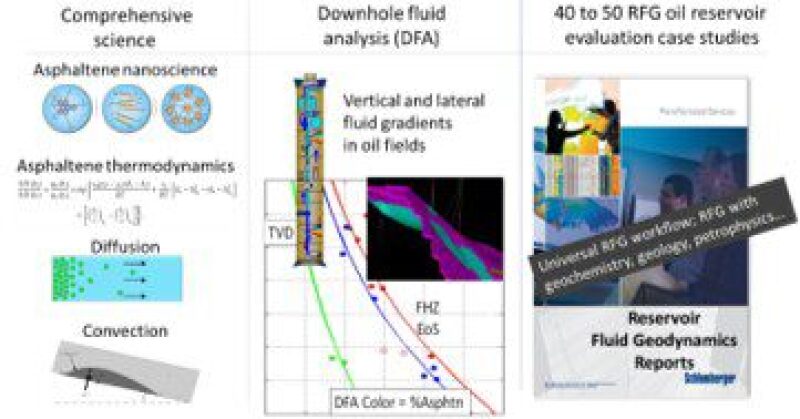
Fig. 3—The initiation of RFG had to await resolution of asphaltene thermodynamics and its application on DFA gradient data. [1] With this accomplished, it is now possible to determine whether reservoir fluids are in their final equilibrated state or are evolving in geologic time due to RFG processes. 50 RFG oilfield studies have been performed (20 released in publications) to systematize various RFG processes; the sum of these processes codifies RFG as a new technical discipline.
Asphaltene Science
First, asphaltene thermodynamics had to be developed. Asphaltene science developments are fairly recent and were complicated by a hierarchical nanocolloidal formation that is codified in the Yen-Mullins model shown in Fig. 4. [3, 4] With this model, simple polymer solution theory could be modified to account for the effects of gravity yielding the Flory-Huggins-Zuo (FHZ) Equation of State (EoS). [5, 6] DFA measurements provide asphaltene gradients vertically and laterally allowing for a thermodynamic characterization of reservoir fluids. [7] Specifically, the thermodynamics of asphaltene gradients in oil reservoirs had to be developed. In order to develop asphaltene thermodynamics, the molecular and colloidal structure of asphaltenes had to be resolved. Specifically, the gravity term requires the size of the asphaltene particles in accordance with Newton’s 2nd law of motion, F=mg; “F” is force, “g” is earth’s acceleration and “m” is mass (of the asphaltene particle). Without the size, thus, mass “m” of the asphaltenes, the force of gravity cannot be accounted for, and modeling of asphaltenes in reservoir crude oils cannot be accomplished. Solving the size of asphaltenes was complicated because asphaltenes have three solubility thresholds, thus three particle sizes. This contrasts a normal solute-solvent system such as sugar and water where there is only a single solubility threshold. The three asphaltene species are delineated in the Yen-Mullins model of asphaltenes. [3, 4]

Fig. 4.—Yen-Mullins model of asphaltenes. [3, 4] Asphaltenes exhibit three solubility thresholds with increasing concentration in laboratory solvents and in crude oils. At the first solubility threshold, asphaltene molecules combine to form nanoaggregates. At the second solubility threshold, nanoaggregates combined to form clusters. At the third solubility threshold asphaltenes undergo bulk phase separation.
At low concentrations in light oils, asphaltenes are dispersed in crude oils as a true molecular solution. At moderate concentrations in black oils, asphaltenes are dispersed as nanoaggregates consisting of 6 molecules. At high concentrations in heavy oils, asphaltenes are dispersed in oil as clusters consisting of 8 nanoaggregates. [3, 4] At yet higher concentrations, asphaltenes undergo bulk phase separation; a photograph of asphaltenes is seen in Fig. 4.
Before it was understood that asphaltenes form nanocolloids, there was great uncertainty as to what was being analyzed in asphaltene solutions. The properties of nanoaggregates or even clusters were incorrectly assigned by some to be molecules fueling debates on basic properties such as molecular weight. The foundations of asphaltene science are described in detail elsewhere. [8]
The “mean” molecular structure of asphaltenes in the Yen-Mullins model has been confirmed by atomic force microscopy (AFM) and scanning tunneling microscopy (STM) molecular imaging. [9, 10] Important validation studies were carried out proving that AFM and STM imaging methods readily image model archipelago molecules confirming that these are at most minor constituents in asphaltenes. [11] The mean structure of asphaltene molecules is required for application of Newton’s 2nd Law of motion. Actual images of asphaltene molecules are shown in Fig. 5.
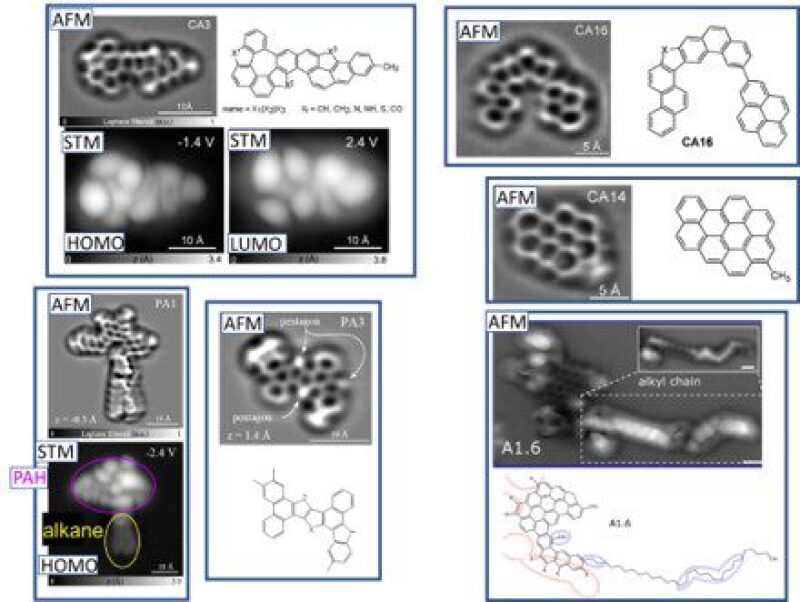
Fig. 5—Direct molecular imaging of individual asphaltene molecules by AFM and STM [9, 10]. AFM images atoms and bonds, while STM images specific molecular orbitals such as the highest occupied molecular orbital and the lowest unoccupied molecular orbital. These stunning images with subatomic resolution confirm the primary precepts of the Yen-Mullins model as stated in the first AFM asphaltene imaging paper. [10] Specifically, the “island” molecular architecture, with a single polycyclic aromatic hydrocarbon (PAH) dominates (molecules CA3, PA1, PA3, CA14, and A1.6). A small fraction of asphaltene molecules contain a single core or aromatic carbon with a direct aryl linkage (CA16). No “archipelago” molecules were found in any asphaltenes, with two PAHs crosslinked by alkanes. [9, 10]
Once asphaltene sizes were determined, then modification of a simple polymer solution theory could be invoked to describe asphaltene gradients in reservoirs. Indeed, use of the cubic EoS is inappropriate for asphaltenes; the cubic EoS is a modification of the ideal gas law. The cubic EoS works for gases and liquids but was never intended for solids. Instead, a simple regular solution theory has been used for asphaltenes with the modification of adding a gravity term giving the EoS (FHZ EoS).[5, 6] This equation is simple because there is only a single chemical interaction parameter each for the solute, the asphaltenes, and the solvent, the crude oil (including dissolved gas) minus the asphaltenes. For similar reasons as to why the cubic EoS works for gas-liquid equilibria for a multicomponent mixture, live crude oil, the FHZ EoS works for asphaltenes in crude oil. Specifically, hydrocarbons are weakly interacting making them “nearly ideal” in the chemical sense. Consequently, simple mixing laws apply for application of the cubic EoS. Asphaltenes are one step more strongly interacting than hydrocarbons, but the invariant adherence of asphaltenes of all types to the Yen-Mullins model allows simple thermodynamic modeling. [12] Indeed, the Yen-Mullins model has been shown to work for petroleum asphaltenes, coal-derived asphaltenes, and immature source rock asphaltenes, which together span a huge range of aromatic to saturate carbon. [12] In addition, the Yen-Mullins model works for asphaltenes in laboratory solvents [3, 4] as well as reservoir crude oils [6, 13].
With asphaltene thermodynamics in hand, it became possible to determine whether reservoir fluids are or are not in their final, equilibrium state. For equilibrated reservoir fluids, there are significant implications about the reservoir, such as, it is likely that the reservoir is connected. [1, 13-15] For reservoirs that contain fluids that are not equilibrated, then it is generally possible to identify the process that occurs in geologic time that precludes equilibrium. [1] These processes taken together define RFG.
The evaluation of solution gas by the cubic EoS is shown repeatedly to be inadequate to determine whether reservoir fluids are equilibrated for many reasons. The measurements of gas-oil ratio (GOR), whether downhole or in the laboratory, generally has large error bars. The GOR gradients are frequently small for incompressible crude oils, thus for low GOR. Small GOR gradients also occur for flashed crude oils, thus, those oil reservoirs with a gas cap. In addition, for different compartments with gas caps and in the same pressure regime, the GORs are necessarily quite similar. For these many reasons, thermodynamic evaluation of reservoir crude oils with the cubic EoS is not sufficiently accurate to launch RFG. Asphaltene thermodynamics of the FHZ EoS is the key enabler for RFG.
Downhole Fluid Analysis on the Ora Platform. A second key requirement for the advent of RFG is the measurement basis to employ the FHZ EoS theory. Highly accurate determination of asphaltene gradients vertically and laterally in reservoirs is needed to enable RFG. The thermodynamic theory grabs ahold of asphaltene gradients. Without accurate gradients, the extent of equilibrium cannot be determined. And since bad data is worse than no data, accurate gradients are of paramount importance. [13] Downhole fluid analysis (DFA) is the key enabler for gradient measurements. [7] With DFA measurements for asphaltene content there is no phase separation, greatly reducing error in measurement, thereby enabling even subtle asphaltene gradients to be determined. These measurements are best performed by relying on the measurement of the depth of color of the crude oil. [16] Indeed, detailed accounting for crude oil has been accomplished using molecular orbital calculations of >500 contributing PAHs, which in retrospect are consistent with the AFM and STM results (cf. Fig. 5). [17-19]
Figure 6 shows an image of the latest generation formation testing tool. [20] Focused flow in the multiport, dual-flowline probe enables rapid clean-up of reservoir crude oils mitigating and often eliminating problems with filtrate of oil-based muds (OBM). In addition, the tool can set very quickly on station and has a wide range of pumping speeds. These capabilities along with others allow rapid measurement of asphaltene gradients even in difficult wellbore conditions.

Fig. 6—The latest generation of wireline formation testing. [20] The focused sampling probe provides fast clean-up of formation crude oils. The efficiency of operations built into this tool allows rapid measurement of fluids gradients by DFA in oils wells even under harsh conditions. This tool enables routine application of RFG in reservoir characterization.
In a typical oilfield campaign, at least several wells are drilled and DFA measurements can be acquired yielding vertical and lateral fluid gradients. Naturally, tool-to-tool variability must be a minimum. Gradient measurements require many DFA stations so the efficiency is a premium. In addition, contamination from OBM filtrate must be eliminated. The latest generation wireline formation testing tool has been designed to solve all of these concerns, thereby making RFG interpretation a routine capability.
RFG Oilfield Case Studies
Finally, in addition to FHZ EoS theory and DFA asphaltene gradient measurements, we must listen to Mother Nature to see what she does when she mixes various charge fluids in the reservoir. Our RFG team has now performed approximately 50 RFG oilfield case studies, which have allowed for the characterization of many RFG processes.
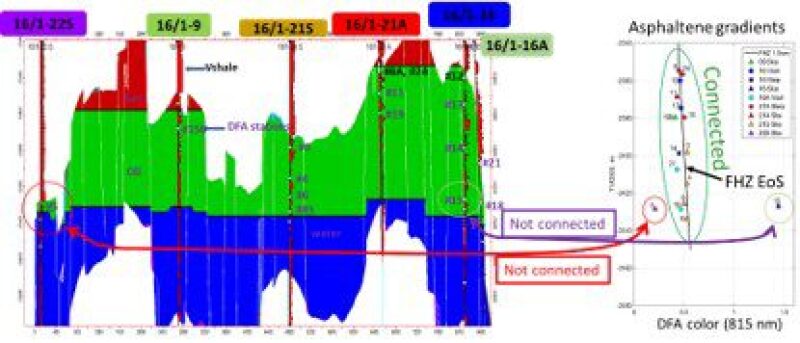
Fig. 7—Successful RFG oilfield case study from Norway for a light oil reservoir. [21, 22] The DFA asphaltene gradient data on the right shows that almost all oil in the reservoir is equilibrated matching the FHZ EoS, thus the reservoir is connected. This prediction matches >2 years of production results. The two outlier points (5 and 15) are not equilibrated and are in small, isolated parts of the reservoir. They differ in asphaltene content due to differences in thermal maturity. [21, 22]
Always, RFG oilfield studies are directed at the biggest concerns and uncertainties of the asset team. In Fig. 7, the biggest concern was reservoir connectivity. The DFA data of the asphaltene gradient shows that almost all (measured) points in the reservoir contained equilibrated oil, thus the reservoir is connected. This prediction matches >2 years of production. Detailed geological analysis of all oil samples showed that the outlier points were in clearly isolated sections of the reservoir and geochemical analysis showed they differed in thermal maturity. [21, 22] That is, geologic features established the isolation of these two reservoir locations, and the lack of equilibrium of these fluids with the rest of the reservoir validated the thermodynamic evaluation of connectivity. Other methods of connectivity analysis fail here and elsewhere. All points in this reservoir including the isolated points are in pressure communication. Pressure equilibration requires almost no mass transfer, consequently pressure communication is often observed in separate flow compartments and is not predictive for flow connectivity. As discussed above, the cubic EoS for gas-liquid thermodynamics is not sufficient to determine reservoir connectivity. All points in the reservoir are in pressure communication and there are gas caps. Consequently, all reservoir oils have been flashed to nearly the same pressure causing the GORs to look equilibrated even for the isolated samples. The asphaltene thermodynamic evaluation is required; for RFG, there is no substitute.
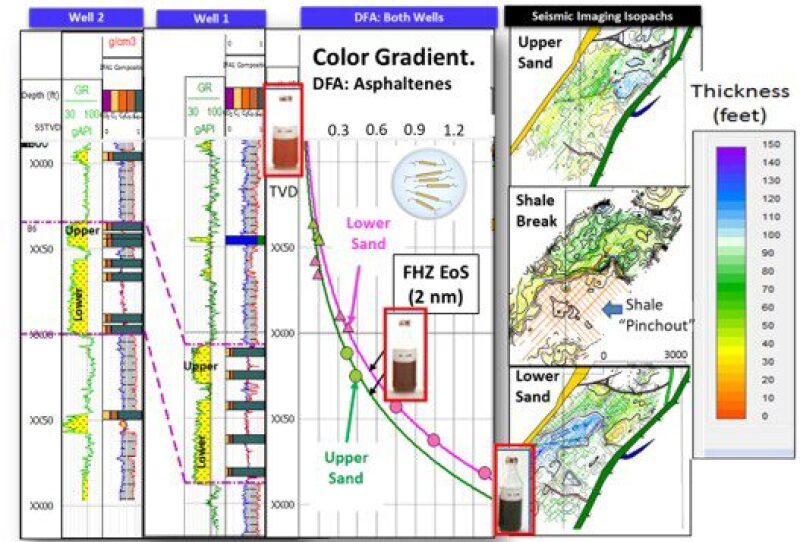
Fig. 8—Log data from two wells, each with two stacked sands with black oil. DFA-measured asphaltene gradients match equilibrium modeling (FHZ EoS) in each of two stacked sands predicting connectivity as confirmed by > 2 years of production. [23] The offset of the two asphaltene gradient curves (pink curve vs. green curve) show that the intervening shale is at least a regional baffle in agreement with the isopach formation thickness maps on the right.[23]
The black oil model of the FHZ EoS using the asphaltene nanoaggregate from the Yen-Mullins model matches the DFA-measured asphaltene gradients in each of the two sands as shown in Fig. 8. This indicates each sand is laterally connected. The isopach formation thickness maps of the upper and lower sands both show that both sands are extensive vertically and laterally consistent (but not proving) connectivity. The offset of the two DFA-measured asphaltene gradients shows that these sands are baffled or sealed from each other. The isopach map of the intervening shale shows it is laterally extensive. In addition, in the putative pinch-out, the shale is less thick than several meters (seismic resolution), but does not necessarily indicate fluid flow. Indeed, the shale was determined to be sealing in a well in the pinch-out area indicated in Fig. 8. [23]
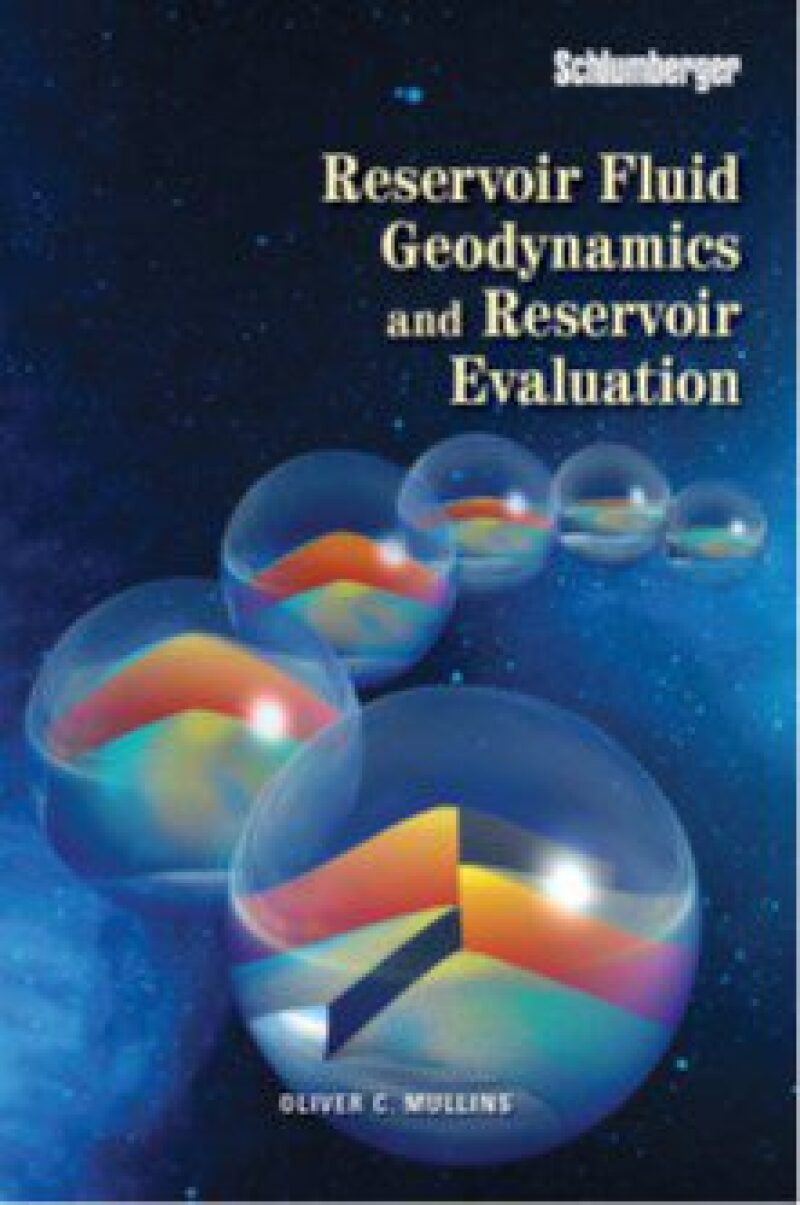
Fig. 9—A new book features RFG and reservoir evaluation. The book provides an overview of RFG and describes 18 (released) RFG oilfield case studies including those in Fig. 7 and 8. There are also chapters on asphaltene science, on petroleum systems and geochemistry, and on mass transport in single phase hydrocarbons in geologic time.
RFG Book and Conclusions
Every discipline requires a book; no book, no discipline. This first book on RFG documents the foundations with emphasis on asphaltene thermodynamics. The 18 oilfield RFG case studies treated in the book validate that the RFG workflow is very useful. Of course, a similar workflow has been used by geologists since the oil industry started, thus, it is not surprising that this workflow accounting for evolution over geologic time also works for fluids. RFG with its thermodynamic foundation is complemented very well by petroleum systems analysis and geochemistry as the book clarifies. Considerations of mass transport including diffusion, convection, and Stokes falling of colloidal particles are all important and discussed in the book. For young professionals and for hungry technologists of all ages, RFG offers a new way to evaluate reservoirs and provides a platform to establish increased value for skilled technologists.
References
1. Mullins, O.C., Reservoir Fluid Geodynamics and Reservoir Evaluation. 2019, Houston, TX: Schlumberger.
2. Tissot, B. and D. Welte, Petroleum Formation and Occurrence. 2nd ed. 1984: Springer. 702.
3. Mullins, O.C., The Modified Yen Model. Energy and Fuels, 2010. 24: p. 2179–2207.
4. Mullins, O.C., et al., Advances in asphaltene science and the Yen-Mullins model. Energy & Fuels, 2012. 26(7): p. 3986-4003.
5. Freed, D.E., O.C. Mullins, and J.Y. Zuo, Theoretical Treatment of Asphaltene Gradients in the Presence of GOR Gradients. Energy & Fuels, 2010. 24(7): p. 3942–3949.
6. Zuo, J.Y., et al., Advances in the Flory-Huggins-Zuo Equation of State for Asphaltene Gradients and Formation Evaluation. Energy & Fuels, 2013. 27: p. 1722–1735.
7. Mullins, O.C., The Physics of Reservoir Fluids: Discovery Through Downhole Fluid Analysis. 2008, Sugar Land, TX: Schlumberger.
8. Mullins, O.C., et al., Asphaltenes, Heavy Oils, and Petroleomics. 2007, New York: Springer.
9. Schuler, B., et al., Heavy Oil Based Mixtures of Different Origins and Treatments Studied by Atomic Force Microscopy. Energy & Fuels, 2017. 31(7): p. 6856–6861.
10. Schuler, B., et al., Unraveling the Molecular Structures of Asphaltenes by Atomic Force Microscopy. J Am Chem Soc, 2015. 137(31): p. 9870–6.
11. Schuler, B., et al., Characterizing aliphatic moieties in hydrocarbons with atomic force microscopy. Chem Sci, 2017. 8(3): p. 2315–2320.
12. Wang, W., et al., Nanoaggregates of Diverse Asphaltenes by Mass Spectrometry and Molecular Dynamics. Energy & Fuels, 2017. 31(9): p. 9140–9151.
13. Mullins, O.C., et al. "The Critical Role of Asphaltene Gradients and Data Integration in Reservoir Fluid Geodynamics Analysis" in SPE Annual Technical Conference and Exhibition. 2017. SPE 187277.
14. Mullins, O.C., et al., The Collodial Structure of Crude Oil and the Structure of Oil Reservoirs. Energy and Fuels, 2007. 21: p. 2785–2794.
15. Betancourt, S.S., et al., Nanoaggregates of asphaltenes in a reservoir crude oil and reservoir connectivity. Energy & Fuels, 2009. 23(3): p. 1178–1188.
16. Mullins, O.C., S. Mitra-Kirtley, and Y. Zhu, The Electronic Absorption Edge of Petroleum. Applied Spectroscopy, 1992. 46: p. 1405–1411.
17. Ruiz-Morales, Y. and O.C. Mullins, Polycyclic Aromatic Hydrocarbons of Asphaltenes Analyzed by Molecular Orbital Calculations with Optical Spectroscopy. Energy and Fuels, 2007. 21: p. 256–265.
18. Ruiz-Morales, Y. and O.C. Mullins, Measured and simulated electronic absorption and emission spectra of asphaltenes. Energy & Fuels, 2009. 23(3): p. 1169–1177.
19. Ruiz-Morales, Y., X. Wu, and O.C. Mullins, Electronic Absorption Edge of Crude Oils and Asphaltenes Analyzed by Molecular Orbital Calculations with Optical Spectroscopy. Energy & Fuels, 2007. 21: p. 944–952.
20. Partouche, A., Edmundson, S., Tao, C., Chen, H., Nelson, K., Sawaf, T.; Yang, B. Xu, L., Dindia, D., Pfeiffer, T., "Applications Of Wireline Formation Testing—A Technology Update." 2020, OTC 30879: Houston, TX.
21. Betancourt, S.S., et al., Gravitational Gradient of Asphaltene Molecules in an Oilfield Reservoir with Light Oil. Energy & Fuels, 2018. 32(4): p. 4911–4924.
22. Johansen, Y.B., et al. "Asphaltene Gradient Analysis by DFA Coupled with Geochemical Analysis by GC and GCxGC Indicate Connectivity in Agreement with One Year of Production in a Norwegian Oilfield" in SPE Annual Technical Conference and Exhibition, SPE 191490. 2018.
23. Chen, L., et al. "A Study of Connectivity and Baffles in a Deepwater Gulf of Mexico Reservoir Linking Downhole Fluid Analysis and Geophysics." in SPE Annual Technical Conference and Exhibition, SPE 187231. 2017.

The article was sourced from the author by TWA Editor Bita Bayestehparvin.

